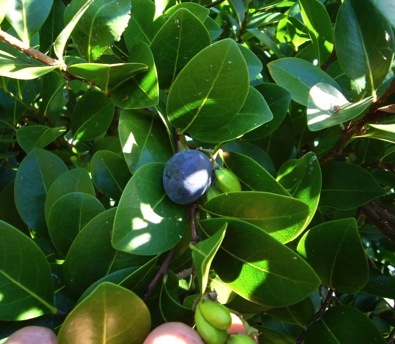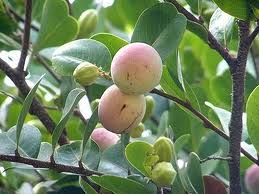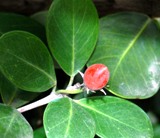Chrysobalanus icaco: Multi-Colored Fruit
Coco-plums are three quarters patriotic: They can be red, white, or blue ( and yellow.)
Actually, the “blue” is deep purple and the yellow more a cream. Trees near the shore tend to have light colored fruit that is round whereas a variation inland tends to be oval and red to dark purple.
Look for the coco-plum in cypress swamps, low areas, tree islands, beaches, sand dunes, canals, riverside, oceanside thickets, hammocks, by lakes, ponds and in landscaping. In reference to landscaping, don’t confuse it with the Natal Plum which also has an edible fruit but the Natal Plum is covered with intense thorns.
The Coco-plum has been introduced to tropical areas around the world. In Florida it is found from the center of the state south. In the wild it grows up to 30 feet tall, but can be trained into a compact hedge as well.
Opinions vary on the value of the fruit. Some think the pulp tastes like astringent sweet cotton. I have always found it soft and sweet. Some will say the blue tastes great and the white tastes bad, where as I have found them to taste the same. It’is made into jams and jellies. In Cuba it’s manipulated into a sweet preserve that’s served in Havana restaurants as a sobremesa or dessert. The large kernel removed from its shell is edible raw or cooked. Some think it has the faint flavor of almond. To me it tastes like granola. Many think the kernel is far better when the fruit and kernel are both pierced so the juice of the pulp is allowed to seep into the kernel.
The botanical name is Chrysobaloanus icaco (crease-oh-BAL-ah-nus eye-KAY-koh. In botanical accounts that haven’t a clue “Chrysobaloanus” is interpreted to mean “Golden Apple.” In more informed but polite reports it is “golden acorn” which is getting closer to the truth. It really means “golden glans” (or the end of human penis.) Carl Linnaeus, the fellow who started giving plants scientific names, was the original dirty old man. The barnacle got the same name as well, Balanus. Icaco, the individual species name, is the modern version of Hicaco which was what the plant was originally called in Taino on the island of Hispaniola. It is said eye-KAY-koh, in the Roman, but eye-KAH-koh is also common.
The oil in the kernel can be substituted for almond oil. The seed is about 21% oil by weight. In fact, the seeds can be strung on sticks and burned like a candle. The oil can also be used to make candles, soap, and axle grease. The kernels (and leaves) can also be used to make a black dye that helps fibers resist decay.
The Coco-plum has has many native medical uses (see Herb Blurb below.) The leaves and bark have been used to treat dysentery and diarrhea, diabetes, bladder problems and kidney issues. Tea from the leaves can make mice hypoglycemic.
With all that said, there is a second Coco-plum, Chrysobaloanus icaco var. pellocarpus (pel-oh-KAR-pus) meaning dark fruit with translucent spots. The pellocarpus lives inland where it’s wet, and has smaller, dark purple fruit. New growth is reddish or yellow.
Green Deane’s “Itemized” Plant Profile
IDENTIFICATION:
Both a shrub to 30-foot tree, leaves alternate, egg-shaped though variable, indented at tip, 1.5 to 3 inches long, leathery, glossy, new growth can be yellow green or reddish. Flowers small and white, in clusters. Fruit white to yellow to red to purple, thin skinned.
TIME OF YEAR: Spring to fall but usually a large crop in late spring and another in late fall.
ENVIRONMENT: Mainland, keys, near the coast or hammocks, inland near bodies of fresh water
METHOD OF PREPARATION: Fruit and kernel raw and or cooked. Made into jelly, jam and syrup. Can be canned.
HERB BLURB
Chrysobalanus icaco; Plasmid pUC 9.1; Escherichia coli; Genotoxic potentiality of aquerous extract prepared from Chrysobalanus icaco L. leaves. .
Abstract: Plants have been related to our lives, being used as medicine, regardless of scientific evidence of side effects. This work analyses the toxicological effects of Chrysobalanus icaco L. aqueous extract, used in different pathologies. It was studied through: (i) alteration of plasmid pUC 9.1 topology; (ii) survival of bacterial strains submitted, or not, to previous treatment with SnCl2; (iii) transformation efficiency of E. coli strain by the treatment with the plasmid pUC 9.1. In (i), the treatment of the plasmid resulted in DNA single-strand breaks (SSB). A decrease of the lethal effect induced by SnCl2 in presence of the extract was found, while no C. icaco bacterial survival reduction was observed. The transformation efficiency of the plasmid was also reduced. Results suggest that the extract could present a potential genotoxic effect, as demonstrated either by the induction of SSB in plasmid or in transformation efficiency experiments. Finally, it presents an antioxidant action.
Chrysobalanus icaco L. extract for antiangiogenic potential observation. Alves De Paulo S, Teruszkin Balassiano I, Henriques Silva N, Oliveira Castilho R, Coelho Kaplan MA, Currie Cabral M, da Costa Carvalho MG. Instituto de Biofisica Carlos Chagas Filho, Laboratorio de Controle da Expressao Genica, Universidade Federal do Rio de Janeiro, Centro de Ciencias da Saude, Bloco C, Cidade Universitaria, CEP 21949-900, Rio de Janeiro, Brasil.
Angiogenesis is an important process in several physiological situations and it is also implicated in the development of some diseases such as diabetes and cancer. This study investigated the antiangiogenic potential of Chrysobalanus icaco methanol extract in the chicken embrionary tissue. Clinical trials for cancer treatment using drugs based on this mechanism are already in progress. Chorioallantoic membrane model (CAM) of chicken embryos, with C. icaco methanol extract in plastic diskes was used. The results showed an average of 44% angiogenesis inhibition in CAM areas with the plant extract compared to the controls. The data indicate that C. icaco methanol extract reduce the formation of new blood vessels in chicken chorioallantoic membrane.





never liked the skin so much, but the pulp and the kernel when fruitful are my favoritie florida trailside nibble! there is a bigger cousin of this chrysobalans imperialis, i think, in sydney’s botanic gardens. the fruits are like cue balls for billiards and not for the eating. it is a rare tree and not very popular.
Questions:
Can the leaves of Red Cocoplum be eaten with dressing or mixed in a salad? Does it taste good? Is it nutritional?
I have no reference to any leaves in the genus (Chrysobalanus) being eaten.
Do you know how to extract the oil? We have about 7 of these planted beside our house and cannot wait to harvest! Thank you!
I live on Eleuthera, The Bahamad.
I find them along the road. It grows in bushes among thick vegrtation of shrubs, trees, palms etc. not far from the beach. I eat them if I feel they are tender and yellowish white. I have been discarding the seeds after chrwing off the pulp.
I also have eaten the dark purple fruit, that grows in bushes more inland. It does taste sweeter when tender ripe.
How does transplanting work? Would love to have the fruit grow on our sandy land. It seems to do well on sandy soil.
Thank you
What is the experience with the Coco Plum root system? Does it grow deep and grows far from the tree itself?
As a child 80 years ago I remember cocoplums being made into a tasty preserve, a sweet for desert time. Do you know how this is made?
I make this similar to other preserves, but because it has a seed inside you kind of mash around it to get most of the flesh off, then strain whatever big pieces of skin and seed are left over. I normally do about a pound and a half and a 1/4 cup of sugar over night, then boil everything and mash it up real good through a strainer.
I have this planted as a screen in two sides of my 6 acres (about 600’ or so). I mainly take my goats for a walk and they eat those that fell on the ground and I pick some for them. I think that they are tasteless myself but maybe I’ll try to make jelly with them. I mainly planted them for the wildlife to enjoy and the birds and small Mammels love them.